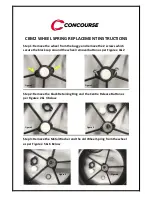
26
Section 6 - Accidental Release Measures
Steps to be Taken in case Material is Released or Spilled
If the battery material is released, remove personnel from area until fumes dissipate. Provide maximum
ventilation to clear out hazardous gases.Wipe it up with a cloth,and dispose of it in a plastic bag and put
into a steel can. The preferred response is to leave the area and allow the batteries to cool and vapors to
dissipate. Provide maximum ventilation. Avoid skin and eye contact or inhalation of vapors.
Waste Disposal Method
It is recommended to discharge the battery to the end, handing in the abandoned batteries to related
department unified, dispose of the batteries in accordance with approved local, state, and federal
requirements. Consult state environmental protection agency and/or federal EPA.
Section 7 - Handling and Storage
The batteries should not be opened, destroyed or incinerate, since they may leak or rupture and release
to the environment the ingredients that they contain in the hermetically sealed container. Do not short
circuit terminals, or over charge the battery, forced over-discharge, throw to fire. Do not crush or puncture
the battery, or immerse in liquids.
Precautions to be taken in handling and storing
Avoid mechanical or electrical abuse. Stored preferably in cool, dry and well-ventilated area, which is
subject to little temperature change. Storage at high temperatures should be avoided. Do not place the
battery near heating equipment, or expose to direct sunlight for long periods.
Other Precautions
Batteries may explode or cause burns, if disassembled, crushed or exposed to fire or high temperatures.
Do not short or install with incorrect polarity.
Section 8 - Exposure Controls, Personal Protection
Respiratory Protection
In case of battery venting, provide as much ventilation as possible.Avoid confined areas with venting
batteries. Respiratory protection is not necessary under conditions of normal use. Ventilation Not
necessary under conditions of normal use.
Protective Gloves
Not necessary under conditions of normal use.
Other Protective Clothing or Equipment
Not necessary under conditions of normal use.
Personal Protection is recommended for venting batteries: Respiratory protection, protective gloves,
protective clothing and safety glass with side shields.
Section 9 - Physical and Chemical Properties
Nominal Voltage:
24V
Nominal Capacity:
25Ah
Electric Energy:
600Wh
Physical State:
Solid
Appearance:
Battery, Battery Pack































